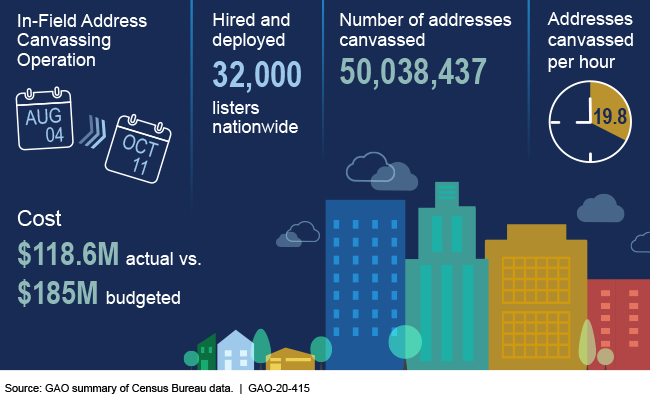2020 Census: Bureau Generally Followed Its Plan for In-Field Address Canvassing
Fast Facts
The Census Bureau began its decennial count of the U.S. population in January 2020. Early operations were generally on schedule—with field staff successfully completing address canvassing for more than 50 million addresses. Ensuring accurate addresses is vital or people may be missed, counted more than once, or included in the wrong location.
But, a shortage of staff put the operation at risk of falling behind. The Bureau is taking steps to recruit enough workers for later operations, including hiring up to 500,000 people to follow up with households that do not initially respond to the census. The 2020 Census is on our High Risk list.

Census data graphic
Highlights
What GAO Found
The Census Bureau (Bureau) completed in-field address canvassing as scheduled on October 11, 2019, despite nationwide hiring shortfalls. The Bureau credits this success to better-than-expected productivity—the actual hourly productivity rate for the operation was 19.8 addresses versus the anticipated rate of 15.8 addresses. The total workload included more than 50 million addresses.

GAO observations of in-field address canvassing found that a majority of field staff (listers) generally followed procedures, but there were a number of exceptions. For example, 14 of 59 listers we observed did not consistently knock on every door as required to confirm the address and ask about “hidden” housing units. Not knocking on doors or asking about hidden housing units represents missed opportunities to potentially add missing addresses to the Bureau's address file. GAO communicated to Bureau officials that listers were not following procedures and they sent out a nationwide reminder for listers to do so.
The Bureau credits efficiency gains to new systems for assigning work and a new reporting mechanism for collecting timecards, but experienced delays in hiring for address canvassing. Though address canvassing productivity was higher than expected, in some parts of the country the operation was at risk of falling behind because of a shortage of listers. The Bureau told GAO that it filled the gap with listers who lived well outside of the area in which they were supposed to work—in some cases from a different state. The Bureau is taking actions to address hiring problems for later operations, including nonresponse follow-up, when the Bureau intends to hire between 320,000 to 500,000 enumerators to follow up with households that did not initially respond to the census. Those actions include increasing wage rates in 73 percent of the counties nationwide.
Why GAO Did This Study
The decennial census is a costly and complex undertaking and its success depends largely on the Bureau's ability to locate every person residing in the United States. To accomplish this monumental task, the Bureau must maintain accurate address and map information for every person's residence. If this information is inaccurate, people can be missed, counted more than once, or included in the wrong location. To help control costs and to improve accuracy, the Bureau used new procedures to build its address list for 2020.
GAO was asked to review how the in-field address canvassing operation performed. This report (1) determines the extent to which the Bureau followed its plans and schedule for in-field address canvassing, and (2) identifies the successes and challenges that occurred during 2020 Census In-Field Address Canvassing that have potential implications for future operations.
To address these objectives, GAO reviewed key documents including the 2020 Census operational plan that discussed the goals and objectives for the operation. GAO observed in-field address canvassing across the country at 18 area census offices, including a mix of rural and urban locations. GAO also interviewed field supervisors, listers, and office management to discuss the operation's successes and challenges.
GAO provided a draft of this report to the Bureau. The Bureau provided technical comments, which were incorporated as appropriate.
For more information, contact J. Christopher Mihm, 202-512-6806, or mihmj@gao.gov.
